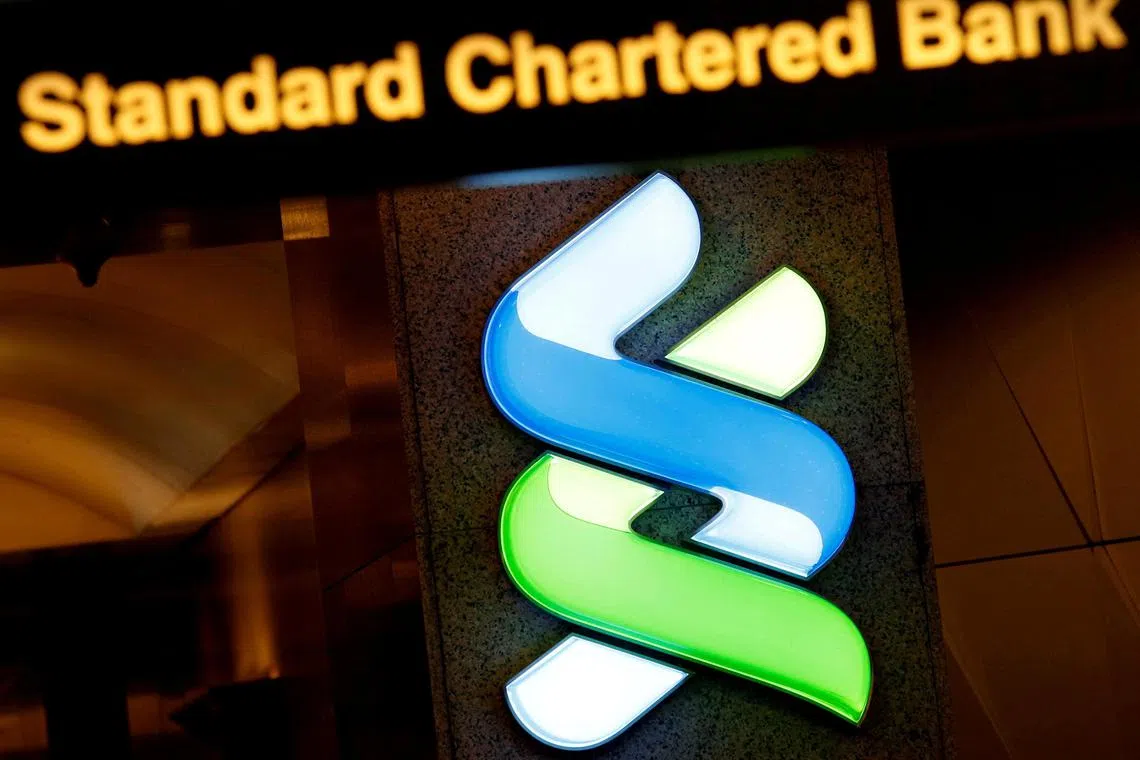StanChart’s Asia CEO ready for bumpy road, bets on China wealth
Sign up now: Get ST's newsletters delivered to your inbox

Standard Chartered, a London-based bank geared toward emerging markets, is heavily exposed to the Greater China region.
PHOTO: REUTERS
Follow topic:
HONG KONG – Standard Chartered’s Asia chief executive officer Benjamin Hung is convinced the Chinese wealth spigots will keep on flowing.
The trajectory of China’s markets continuing to open is clear despite challenges at “this moment in time”, Mr Hung, 59, said in an interview in Hong Kong, the bank’s biggest market.
StanChart, a London-based bank geared towards emerging markets, is heavily exposed to the Greater China region. Like other global lenders, StanChart has to navigate a deteriorating geopolitical climate and slowing growth that have prompted Wall Street firms including Goldman Sachs Group and Morgan Stanley to scale back on ambitious plans in China.
Amid such tensions, increasingly, China has been trading with other Asian countries. Banks including Singapore’s second-largest lender, OCBC Bank, are targeting such flows, to capitalise on shifting supply chains. StanChart is looking to bank on this too.
“What you’re seeing is that fundamental need of Chinese wealth looking for a way to diversify,” said Mr Hung, adding that firms are also looking to spread investments. China to Asean cross-border income at the bank grew 82 per cent in the first half of the year, reflecting the trade flow shifts.
The mood towards China has turned bearish as its economy sputters, pushing the yuan towards a 16-year low. Foreign investor sentiment has also soured as President Xi Jinping’s willingness to sacrifice economic priorities for security concerns rock the private sector and throttle dealmaking.
The broad direction is that “they have to open up”, said Mr Hung, adding that the speed will be “calibrated” and depends on factors such as China’s reserves and its currency’s strength. To Mr Hung, the challenges facing China are “cyclical” rather than structural.
With China and Hong Kong accounting for US$1.2 billion (S$1.6 billion), roughly 37.6 per cent of the bank’s total pre-tax profit during the first half, there is plenty at stake. The lender is pushing ahead with a plan to invest US$300 million in China by 2024.
Veteran banker
The 30-year veteran at the bank took over as the chief for Asia during the pandemic in 2021, helming a region that accounts for US$2.7 billion, or more than 80 per cent, of the bank’s first-half pre-tax profit. He has seen the bank through cycles since returning to the region.
He worked his way up the ranks in a wide range of roles, from investor relations to retail and corporate banking to heading up the North Asia region. Mr Hung oversees 21 markets in Asia, including smaller markets such as Cambodia.
“I’ve been back long enough that the road is, has always been bumpy,” said Mr Hung. “There are some blow-ups always somewhere.”
The lender operates out of two hubs in Asia, Hong Kong and Singapore. Of the two, Singapore has the larger headcount with 9,000 people, and is also home to regional and global roles. Mr Hung is based in Hong Kong where the bank has a bit more than 6,000 staff.
As China and the Chinese territory reopened earlier in 2023, StanChart saw new account openings among affluent clients triple in Hong Kong. The global wealth business hauled in an operating income of US$1 billion as net new money more than doubled to US$12.9 billion.
While banks are laying off staff, StanChart is still hiring
“If you see prospects, we also want to invest,” he said, adding that the bank is also finding “surplus areas” to streamline.
The country where it has the biggest headcount is India, and Mr Hung is bullish on the subcontinent’s prospects. “I’m a big believer in a South Asia led by India. I think this is actually India’s decade,” he said, adding that India is structurally like China 10 to 15 years ago.
Middle East
Mr Hung, who visited the Middle East three times in 2023, also sees a “huge amount” of money flowing between China and the region as Chinese companies expand. He is a member of the Hong Kong Chief Executive’s Council of Advisers and was part of a delegation for Chief Executive John Lee’s first official visit to the Middle East in 2023.
Asset managers and sovereign funds from the rich oil states are currently “very underweight” Asia and China and need to find a home to invest their money. “If you are currently underweight certain areas, then naturally more and more money will be rebalanced,” said Mr Hung.
StanChart itself could emerge as a target for Middle Eastern money. First Abu Dhabi Bank has explored a potential bid for the company, Bloomberg reported at the start of 2023. The bank said in February it had considered an offer but was not currently doing so, which means it cannot make another takeover approach for six months, except under certain circumstances.
Mr Hung said that he did not meet with First Abu Dhabi Bank when he was in the Middle East. When asked if he sees the First Abu Dhabi Bank bid coming back, he said: “You have to ask them.”
Chief executive officer Bill Winters “asked me to make sure I deliver on the potential in Asia and that’s what I’m focused on”, said Mr Hung. “My simple view is I see a lot of potential in this franchise.” BLOOMBERG

